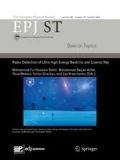Abstract
Observed efficiencies of industrial power plants are often approximated by the square-root formula: 1 − √T −/T +, where T +(T −) is the highest (lowest) temperature achieved in the plant. This expression can be derived within finite-time thermodynamics, or, by entropy generation minimization, based on finite rates for the processes. In these analyses, a closely related quantity is the optimal value of the intermediate temperature for the hot stream, given by the geometric-mean value: √T +/T −. In this paper, instead of finite-time models, we propose to model the operation of plants by quasi-static work extraction models, with one reservoir (source/sink) as finite, while the other as practically infinite. No simplifying assumption is made on the nature of the finite system. This description is consistent with two model hypotheses, each yielding a specific value of the intermediate temperature, say T 1 and T 2. The lack of additional information on validity of the hypothesis that may be actually realized, motivates to approach the problem as an exercise in inductive inference. Thus we define an expected value of the intermediate temperature as the equally weighted mean: (T 1 + T 2)/2. It is shown that the expected value is very closely given by the geometric-mean value for almost all of the observed power plants.
Similar content being viewed by others
References
F.L. Curzon, B. Ahlborn, Am. J. Phys. 43, 22 (1975)
A. Bejan, in Advanced Engineering Thermodynamics (Wiley, New York, 1997), p. 377
M. Esposito, R. Kawai, K. Lindenberg, C. Van den Broeck, Phys. Rev. Lett. 105, 150603 (2010)
G.B. Moreau, M.L.S. Schulman, Phys. Rev. B 85, 021129 (2012)
H.B. Reitlinger, Sur l’utilisation de la chaleur dans les machines à feu (“On the use of heat in steam engines”, in French) (Vaillant-Carmanne, Liége, Belgium, 1929)
P. Chambadal, in Les Centrales Nucléaires (Armand Colin, Paris, France, 1957), pp. 41–58
I. Novikov, J. Nucl. Energy II 7, 125 (1958)
A. Vaudrey, F. Lanzetta, M. Feidt, J. Noneq. Therm. 39, 199 (2014)
G. Lebon, D. Jou, J. Casas-Vázquez, Understanding Non-equilibrium Thermodynamics: Foundations, Applications, Frontiers (Springer-Verlag, Berlin, Heidelberg, 2008)
B. Andresen, Angew. Chem. 50, 2690 (2011)
A. Bejan, J. Appl. Phys. 79, 1191 (1996)
M. Borlein, Kerntechnik (Vogel Buchverlag, Wurzburg, Germany, 2009)
W. Thomson, Phil. Mag. 5, 102 (1853)
M.J. Ondrechen, B. Andresen, M. Mozurchewich, R.S. Berry, Am. J. Phys. 49, 681 (1981)
H.S. Leff, Am. J. Phys. 55, 602 (1986)
B.H. Lavenda, Am. J. Phys. 75, 169 (2007)
R.S. Johal, R. Rai, Europhys. Lett. 113, 10006 (2016)
R.S. Johal, Phys. Rev. E 94, 012123 (2016)
Y. Izumida, K. Okuda, Phys. Rev. Lett. 112, 180603 (2014)
M.J. Moran, H.N. Shapiro, D.D. Boettner, M.B. Bailey, in Fundamentals of Engineering Thermodynamics, 7th edn. (Wiley, New York, 2010), Chap. 7
H. Jeffreys, Theory of Probability, 2nd edn. (Clarendon Press, Oxford, 1948)
E.T. Jaynes, Probability Theory: The Logic of Science (Cambridge University Press, Cambridge, 2003)
P.S. Laplace, Memoir on the Probabilities of the Causes and Events, Stat. Sc. 1, 364 (translated by S.M. Stigler, 1986)
E.T. Jaynes, The evolution of Carnot’s principle, in Maximum-Entropy and Bayesian Methods in Science and Engineering, edited by G.J. Erickson, C.R. Smith (Kluwer, Dordrecht, 1988)
J. Yvon, The Saclay Reactor: Two years experience in heat transfer by means of compressed gas as heat transfer agent, in Proceedings of the International Conference on Peaceful Uses of Atomic Energy (Geneva, Switzerland, 1955)
R.S. Johal, Phys. Rev. E 82, 061113 (2010)
G. Thomas, R.S. Johal, J. Phys. A: Math. Theor. 48, 335002 (2015)
P. Aneja, R.S. Johal, J. Phys. A: Math. Theor. 46, 365002 (2013)
R.S. Johal, R. Rai, G. Mahler, Found. Phys. 45, 158 (2015)
Author information
Authors and Affiliations
Corresponding author
Rights and permissions
About this article
Cite this article
Johal, R.S. Efficiencies of power plants, quasi-static models and the geometric-mean temperature. Eur. Phys. J. Spec. Top. 226, 489–498 (2017). https://doi.org/10.1140/epjst/e2016-60265-9
Received:
Revised:
Published:
Issue Date:
DOI: https://doi.org/10.1140/epjst/e2016-60265-9




